ITF: Evolution or Separation? Part 1: Re-introducing the Kihaps! |
Some interesting situations are developing in the ITF world of Taekwon-Do, situations
that in theory could be argued as limited to an organisation, but in fact have wide implications to the rest of the Taekwon-Do world and those that practice the ITF style. In the current state of affairs we see three different ITF groups, similar large and small organisations (GTF etc.) around the world and a multitude of solo schools, all teaching the Ch'ang Hun system in one guise or another. Different groups and organisations focus on the system of Taekwon-Do they had when perhaps they broke away from the ITF of yesteryear; there are differences, but to most these are minor. Even with the on-going sine-wave discussions still raging, most students are able to cohesively see past it all and train and compete together on a reasonable equal footing. The average Taekwon-Do student would prefer unity amongst practioners and the big organisations, as even though they may be in different federations they can continue to train and compete side by side. However, though the major ITF organisations claim unity (or tolerance of others from the various groups) as an aim, a couple of situations are causing a divide that will separate all students under this banner from virtually all other students around the globe. There are many rumours around at the moment, but the following two situations are not rumour, but fact! One is relatively minor compared to the other, but shows a division none the less, and it is these two situations that I wish to discuss further with the readers and fellow students of Taekwon-Do. Whenever a Dan grade is questioned on certain things that don't quite make sense, there usually follows an unsatisfactory answer of ".. because the organisation requires it that way" and most questions that get this answer refer to changing the way of doing something that doesn't seem quite as beneficial as the original way, in short, they do it because the organisation has told them to! Like the controversial changing of the sine wave, which has been discussed all over the internet, despite reasons given by those at the top of the tree, many remain unconvinced it was anything more than a political move (as opposed to something truly beneficial for the student of Taekwon-Do), despite some arguments for it, including scientific studies (after the fact). Strangely enough, those that support it often simply state something like "well, it does feel better" or similar! Anyway, I digress; the two main changes I want to discuss here are the re-introduction of the Kihaps in the Ch'ang Hon Tul and something that has even wider repercussions, as both these changes further alienate those members of that particular ITF from the rest of the Taekwon-Do world! I guess, compared to the second change, the re-introduction of the Kihaps is actually a minor one. However, the reason for doing it remains unconvincing to me! The ITF-Canada (Choi, Jung Hwa's group and herein known as ITF-C) state the reason for this re-introduction was that "Master Choi firmly believes it was his father's intention to re-introduce the kihaps..." however, this cannot be so as it was General Choi himself that took out the Kihaps in the first place and during his 50 or so years at the head of the ITF he never once even mentioned re-introducing them, so where does this "belief" come from, more so as its expressed 6 years after the arts founder past away! Furthermore, the Kihaps in the patterns were originally intended to further cultivate the development of Ki energy alongside other Ki energy exercises such as Dan-jun breathing. I wonder if these further aids will be introduced and whether we`ll see Taekwon-do masters performing Ki feats like the Shaolin monks or if it will remain a grunt at a certain move in the pattern, with no more focus or relevance than a simple shout! For those who are actually in the ITF-C that are now listed with the task of adding all the kihaps there is some help you can get in reference form. To help with these new requirements you can actually get a list of where the kihaps originally were in the kup patterns (and so should be now re-introduced) in the 1971 books by Grandmaster Jhoon Rhee, as well as a complete list in the more recent (2006) book "Ch'ang Hon Taekwon-Do Hae Sul" by Stuart Anslow, they are also listed on http://www.kidokwan.org As I have said, this is just one step that alienates my brother Taekwon-Do practitioners and the next item up for discussion does this even further, as ITF-C have decided to rename the pattern "Ju Che"! However, I do not feel this has been looked into in that much detail or given as much thought as it should of been and I shall tell you why over the next few paragraphs! ITF: Evolution or Separation? Part 2: The changing of Ju che (Originally scheduled to be published in Combat magazine) Following on from the September article regarding the reintroduction of Kihaps in the patterns, we now discuss the renaming of Ju Che by ITF-C. It's an interesting subject for discussion, more so by the way it's been implemented as well as some of the deeper facts involved in it all. First of all I don't wish to offend anyone, so ITF-C stalwarts should probably stop reading here. It's an interesting occurrence, with far reaching consequences, that affects thousands of students around the world, both from within the ITF-C camp, as well as those who still practice Kodang tul or Ju Che from other groups. Now, whilst I do not disagree with the renaming of the pattern Ju Che, I also do not agree with renaming it either and I will explain why later. Also, ITF-C are not the first to rename the pattern Ju Che as the ICTF (based in Canada) already did so and both utilised the same reasons which were of course due to the 'real' meaning behind Ju Che and the fact that the pattern was made to appease the North Korean dictator Kim, Il Sung. A fact not widely known maybe 20 years ago, but well known today by those who chose to look and certainly by those at the top of the ITF ladder. The problem is that whilst the ICTF chose to pick a brand new name for the pattern and renamed it "Chang Hon" after General Choi, ITF-C have chosen to rename it "Ko-Dang" and Ko-Dang is already a Taekwon-Do pattern! Their statement to their membership confirms this and reads "Dear Taekwon-Do practitioners, Please be advised that effective immediately, the tul of "Ju Che" will be known as it was originally created by our founder General Choi Hung Hi as "Ko-Dang". Taekwon-Do, the Korean martial art was created by our founder to be free of religious and political ideologies. It was General Choi's wish to leave Taekwon-Do to humanity, free of any influence from religion, government and political influence accordingly, it was decided to revert the name to the original name chosen by General Choi. As we make this change, the ITF reaffirms its desire to remain independent and true to the teachings of our founder. ITF Administration" ITF-C's Master Dalton wrote an extensive thesis on Ju Che/Ko-Dang which I recall reading a number of years back (I think it was for one of his Black belt thesis) and this has been re-edited in more detail to support the change and it's an excellent piece in itself. It is being used to give some strength behind the name changing and it does describe the 'Ju Che' philosophy and gives some good details on both Ju Che and Ko-Dang and makes for compelling reading (it can be found at http://www.iutf-tkd.com/thesis%20-Mr.Dalton.html). However, despite being a great piece, it still doesn't give a decent reason for changing the name to Ko-Dang above and beyond the not liking of the ideal of 'Ju Che', which is fair enough, but the ITF-C were technically formed in 2001, prior to the passing of General Choi and I am left to wonder why it has taken 7 years for someone to not like the connection of Ju Che! Furthermore, there are plenty of Taekwon-Do students who don't agree with the Ju Che ideal, but still practice the pattern simply because they consider it following the art of General Choi, the good and the bad! The renaming of Ju Che can be seen as fair game considering what 'Ju Che' really represents or more so why it was introduced as a Taekwon-do pattern, as well as the arguments put forth by Master Dalton, but there are a number of issues with not only naming it "Ko-Dang" but also the reasoning given for renaming it by the ITF-C administration themselves and this is important for students of the art who are reasonably new to it or do not know the history of the ITF or the patterns. First of all the statement is incorrect as it states "..tul of "Ju Che" will be known as it was originally created by our founder General Choi Hong Hi as "Ko-Dang". However, Ko-Dang is a different and separate pattern to Ju Che. Ko-Dang was never renamed Ju Che at all. Ko-Dang was dropped for reasons I'll discuss below and replaced with Ju Che in 1986. Furthermore, it is well known that Ju Che was actually designed by Master Park, Jung Tae in the early eighties and not General Choi himself, though of course General Choi would have had the final say-so on it! Secondly, and this is where the alienation issue comes in; there are millions of Taekwon-Do students around the world that already practice Ko-Dang tul, so renaming a pattern with the name of a pattern already practiced by millions seems ludicrous! Can you imagine a competition whereby two students are side by side and both called out "Ko-Dang Tul Sir" as their pattern of choice and then proceed to do two totally different patterns! At the very least I would have expected a bit more thought into what to actually rename it to! Thirdly, they are using the reasoning that "Taekwon-Do, the Korean martial art was created by our founder to be free of religious and political ideologies. It was General Choi's wish to leave Taekwon-Do to humanity, free of any influence from religion, government and political influence accordingly, it was decided to revert the name to the original name chosen by General Choi". If Taekwon-Do is to be changed to totally fit that reasoning, does that mean that Won-Hyo (religious), Joong-Gun (political) and So-San (religious) are all to be renamed as well, as technically, following that reasoning they should be, even Ko-Dang was a political activist! Furthermore, if this were so, Ju Che would never have been introduced in the first place! The above reasoning also contradicts the final part of the statement where it says "As we make this change, the ITF reaffirms its desire to remain independent and true to the teachings of our founder." as by changing it they are not really remaining true to the founders teachings, as he didn't change it! Ju Che tul and the real facts behind it are a black mark in Taekwon-Do's history, however, it IS Taekwon-Do's history none the less and to wipe it out is not the answer, as without this part of Taekwon-Do's history it is doubtful Taekwon-Do would be at the worldwide stage it is today! Furthermore, in years to come, thousands of students will not know of this point in Taekwon-Do's history, when they should! Wiping out the past to make things look more rosey is always a bad move. It should simply be accepted and taught as it really was! Furthermore, "human rights monitoring organizations and political analysts in several parts of the world continually report that the actual situation in North Korea bears no resemblance to Ju Che theory" (quoted from http://en.wikipedia.org/wiki/Ju Che) so in fact the changing of the name by ITF-C is actually more to do with the terrible regime in North Korea (one I'm sure we all feel the same about) and not really the Ju Che philosophy at all once you read the quoted section, as experts state that though the North Korean government may tout it as fact, they are not actually using it anyway, which brings even more prominence to my final points at the end of this article. Another interesting point I came across in my research concerns the actual Korean language itself. According to Mr. D.G. Nowling (VI Dan, Director of the Kido Kwan) the term Ju Che has its origins in the Chinese language and not Korean. In Hanja (Chinese) Ju Che simply means "Master of the Body" or "Master of Self." And according to Mr. Nowling it is a far cry from what from what Ju Che was originally meant to be according to the founder of Ju Che and has changed several times under both Kim, Il-Sung and Kim, Jong-Il. So to take it by its literal translation in the original language of Taekwon-do doesn't really go too much against the grain, though I guess it's really down to how much you want to read into it! Before I go onto the final points as to why renaming 'Ju Che' to 'Ko-Dang'; a pattern already in existence, is more than just an ill thought-out move, there is a slight error (in reasoning) in the thesis written by Master Dalton. In it Master Dalton quotes an ITF forum poster's words which finishes with "The swastika has been known to symbolise many things such as Sun, Power, Strength, and good luck, throughout history. All of those concepts sound good, don't they? Well, that symbol is now tainted to the world because of the Nazi party of the mid-twentieth century and it's known now as an abomination. What once was good is now considered evil. My point? Ju Che is tainted in much the same way as the swastika. I, for one, find this to be sad. But it is a fact. Can you imagine the outrage if a martial art were to have a Swastika pattern?" Though I agree that the Nazi's tainted this symbol in this way, it is incorrect to claim it is no longer in use because of it, especially in martial arts. Shorin-ji Kempo use a (reversed) swastika for one, the WTF uses a similar diagram for the poomse (pattern) Ilyo and the Hindu religion also uses it! However, the main problem with simply renaming 'Ju Che' to 'Ko-Dang' is that by doing so it is very disrespectful to Ko-Dang himself! Ko-Dang (the Pseudonym of the patriot Cho, Man Sik) was an original pattern formulated by General Choi as one of the first 20 tuls of the ITF. As most know, the patterns are named after famous Korean patriots and Ko-Dang tul is no different. Cho, Man Sik was a Korean independence fighter during the 1930's to 1940's who was in conflict with the communist movement in North Korea. As a political leader, Sik was in direct opposition to Kim, Il Sung. Though unconfirmed, it is widely believed that Kim, Il Sung executed Ko-Dang sometime in the 1950's! The 'official' explanation for the removal of pattern Ko-Dang with pattern Ju Che was that General Choi was still developing Taekwon-Do and that new techniques needed to be added after the completion of the 24 patterns and these new advanced techniques needed to be incorporated via a new pattern. To retain the 24 patterns of Taekwon-Do one had to be replaced and Ko-Dang, being the most junior patriot, was chosen! However, by those who have studied this episode of Taekwon-Do history, it is generally agreed that 'Ju Che' was introduced to appease the North Korean dictator Kim, Il Sung in return for funding for the ITF, after such funding was refused by other countries. As pattern Ko-Dang was known to honour a rival of Kim and his regime, as well as the rumour than Kim actually had him executed for his beliefs, it needed to be erased from the ITF system or no funding would be forthcoming - so it duly was! Some see this as a pure business move on behalf of General Choi, others believe it was uncalled for, but whatever your thoughts, it is now part of the history of Taekwon-Do and especially the ITF! Regarding the business move, I have heard an interesting snippet regarding the 'facing' of the pattern prior to starting. According to the ITF diagrams that use the A, B, C method, nearly all the patterns start on 'C' and face towards 'D' (or in the case of a cross type diagram, start in the centre facing 'D'). However, Ju Che starts on 'D' with its back to 'C' and rumour has it that this was as an insult for having to appease the North Korean dictator in this way! How much truth is in that I do not know and it may have been thought of in that way at the time, however Ul-Ji tul actually starts in a similar fashion, though there may be an entirely different reason for that! You might believe that renaming 'Ju Che' to 'Ko-Dang' is actually the right thing to do, considering the murderous history of it all (though we won't mention Ge-Baek who murdered his whole family) and that it may be righting a wrong and perhaps it would have been if the whole pattern were replaced with the original Ko-dang moves and all, but simply renaming it doesn't fulfil this as to keep the pattern, albeit with another name, dishonours the heroic freedom fighter Cho, Man Sik himself! For a start, even the 'official' pattern meaning has reference to Kim, Il Sung and his warped philosophy and he is the man that is rumoured to have murdered Cho, Man Sik (Ko-Dang). Even if this is changed to the original pattern meaning for Ko-Dang (Pseudonym of the patriot Cho, Man Sik, who dedicated his life to the Korean Independence Movement and to the education of his people. The 39 movements of the pattern show the number of times he was imprisoned) the pattern diagram is a reference to the Baekdu Mountains, which in itself is a hidden reference to Kim, Il Sung and the birth of the Ju Che philosophyagain, plus of course the number of movements will no longer correlate, though considering the rest, that is a minor thing indeed. In the autobiography of Kim, Jong Il (by Tak, Et Al) it is claimed that Kim, Jong Il was born on Baekdu mountain after his father defeated the Japanese invaders and had a "light-bulb" moment that formed the 'Ju Che' ideal.. and this is now used in the doctrine to the North Korean people, all of which is used to suppress and brainwash them and the main reason why ITF-C claim to want to change the pattern name. As a note, Kim, Jong Il was actually born in Vyatskoye, a small town near Khabarovsk, Siberia, in what was then the Soviet Union, where his father, Kim Il-Sung, commanded the 1st Battalion of the Soviet 88th Brigade and fled to after a raid to avoid the Japanese army. His birth name was actually Yuri Irsenovich Kim (Reference: "Under the Loving Care of the Fatherly Leader: North Korea and the Kim Dynasty" by Bradley K. Martin). Furthermore, with just a little research, it is plain to see there are hidden references within the pattern that are connected to Kim, Il Sung; the most major one being the ready posture which many believe is an appeasement of the numerous statues found of Kim around North Korea. The 1st movement is also (some believe) a similar reference to the Baekdu mountains in the way its formed, again a hidden reference to the man rumoured to have murdered Ko-Dang or a human symbol similar to the symbol that represents the Ju Che philosophy! There may be even more, though I have not studied it that deeply to know and I guess only its creator, Park, Jung Tae would know and he is sadly deceased, though it was not an uncommon practice as before Ju Che came to be made, similar practices were used in the systems final pattern Tong-Il, with moves representing certain things! To finalise, renaming the pattern because they do not like what it stood for is fine except that history should of taught us not to try to erase the past but simply learn from it. Renaming it Ko-Dang however, is either foolish due to the fact that there is already a Ko-Dang tul, or ill thought through because of what the pattern also represents even without its name. As each pattern is meant to be performed in reflection of the person it was created after, renaming it from Ju Che to Ko-Dang leaves it with an ambiguous identity at best, lacking in substance, historical relevance and fact! If the ITF-C is that bothered about it why not simply drop it altogether and enforce the practice of the original Ko-Dang tul, which seems to me a more fitting pursuit in purpose and the best way to make their point! As an aside, whilst researching this article I came across many discussions concerning the change and very few felt renaming it "Ko-Dang" was a good idea. One set of postings asked "If it were in your hands to rename pattern "Ju Che" what name would you chose and why?" Various answers were given, from "Cho, Man Sik" to "Hong Hi", but (and without blowing my own trumpet) the answer I gave seemed quite fitting and that was because not only had I chosen a new and original name for the pattern, meaning the original Ko-Dang tul and meaning remained untouched, but I also devised a new meaning for the pattern, that was neither Ko-Dang's or Ju Che's but still reflected this turn of events. I replied that the pattern should be renamed "Jung Tae" with the pattern meaning reading as this: 'Pattern Jung Tae is named after its designer, Master Park, Jung Tae. Formerly known as Ju Che, this pattern was devised in order to gain funds to further ITF development. The 45 movements of the pattern represent 45 degrees, the change in direction required at the time to fulfil the requirements of the time and the diagram represents the forked path taken!' - Quite an interesting and fitting revision I feel, if it were to be made a reality. One I truly feel that ITF-C should consider and are free to use, with my blessing, should they be so inclined and fore-sighted! If you have read this far and are enraged already by my arguments I strongly suggest you stop reading now, because there is a further twist to all this, one that perhaps sees this area of Taekwon-Do history coming full circle (at least it would have if Ko-Dang tul had replaced Ju che in its entirety, movements and all). In the 1980's Ko-Dang was replaced with Ju Che to help the ITF (as explained previously), as no-one but the North Koreans would issue the funding required at the time. In 2008, this is reversed (in a way) and instead of changing something to appease North Korea, now it has changed to perhaps appeases South Korea! You see it has been reported in many Korean news papers (and other sources) that Choi Jung Hwa (head of ITF-C) wishes to return to South Korea to live. A noble wish for sure and one I hope he gets fulfilled as he is Korean, though more for him personally rather than the way it will elevate the ITF-C, which of course it will. But still, many are wondering if, like the removal of Ko-dang for the North Koreans, if renaming Ju Che is a similar act of goodwill to appease the South Korean government in the same vein: hence full circle or if it's for more personal reasons, as though the 'acts' of goodwill may seem similar, the reasons largely depend on the 'whys' and the 'outcomes' and whether, when it all adds up, it was a personal thing with a personal gain to be made (a thought of one forum poster) because thousands of people has been affected by it or something on a wider scale for the benefit of the ITF-C itself. I guess time will tell and history will decide on that, although uniting the ITFs or even working together in unity would be of greater benefit than claiming a large following in South Korea. I have no axe to grind with any organisation, as I am not part of any of them anymore, however I do love Taekwon-Do with a passion and don't want to see it abused or used, as it has been so many times before and the ITF's carry much weight regarding Taekwon-Do and its directions and to me and others (the small fish in the big pond), this is a big thing and something to be addressed and discussed rather than just accepted 'as is'! That said, I am left to wonder if perhaps there is more to all this than meets the eye, first ITF-C changed the Jumping Reverse Dodging kicks to hooking kicks in Ju Che (why didn't they change the nameto ko-dang then out of interest!), the re-introduction of the Ki-haps, the ill-thought out renaming of Ju Che tul, the only Taekwon-Do forum on the internet that has very little outside influence due to the fact that non-ITF members would have to pay to be part of it (obviously most wouldn't due to the numerous other Taekwon-Do forums on the internet already that are free)! My point: Many will know of a certain American Taekwon-Do organisation that changed its Taekwon-Do to be so totally different from everyone else's that it was extremely hard for its members to 'jump ship' and I hope ITF-C isn't going this route as the Taekwon-Do worlds need unifying, not more barriers to keep us apart! As a further interest, in a recent interview with the head of ITF-C, Choi, Jung Hwa, just a few months back, none of the above was mentioned at all and with it being such a big thing I cannot think why not! The most significant change mentioned in this interview was that they were considering the removal of the belt system to curb ego amongst practioners, an interesting concept but something which has not happened yet and something I doubt actually will, perhaps for the very reasons he stated they wanted to do it in the first place. If it does happen, more power to them and it shows principles are more important than numbers of members or the fees that obtains. Some will champion all the changes, others will agree or disagree but remain silent, whilst others, like me will question and discuss them and in the end, time will tell what happens and in time, the changes will be another chapter in the history of Taekwon-Do, I just hope the 2nd tenet was part of all these changes as history is something we should never forget. If anyone has any views regarding the name change etc. or this article, you can email the author at Juche-Kodang@kidokwan.org. If any high ranking member of ITF-C (or any of the other ITF's) would like to respond to this article, please feel free to do so via the pages of Combat/Taekwon-Do & Korean Martial Arts magazine as I'm sure the readers, as well as myself and many Taekwon-Do students would be interested in your viewpoint on all this! |
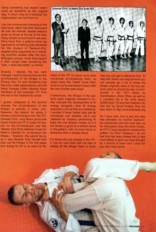
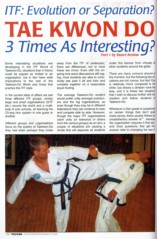

Ju Che in Hangul (and Hanja) |
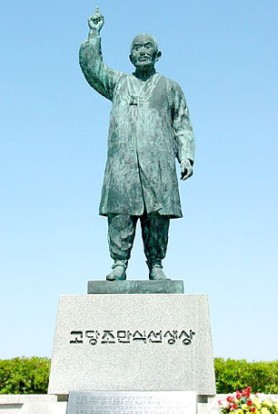
Statue of Cho, Man Sik at the Odusan (Unification Observatory). The hangul reads
"Cho ,Man Sik Teacher" |
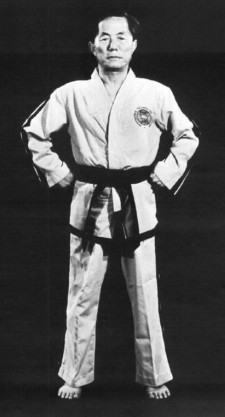
General Choi in the ready posture for Ju Che tul |
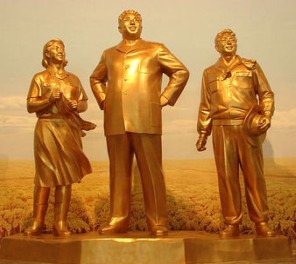
A statue of Kim in the Pyongyang subway in North Korea |